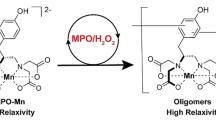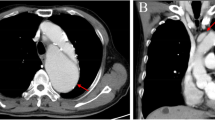Abstract
The objective of this research was to estimate whether a [99mTc]duramycin probe can be used for apoptosis imaging in patients with aortic aneurysm (AA). Vascular smooth muscle cell (SMC) apoptosis has an important influence on AA development. Thus, non-invasive imaging of SMC apoptosis may be able to evaluate AA progress and risk stratification. SMCs were treated with hydrogen peroxide (H2O2; 200 μΜ) or culture medium as a control. Apoptosis was measured using flow cytometry and [99mTc]duramycin to detect the binding efficiency to apoptotic SMCs. C57/BL6 mice were administered angiotensin-II and beta-aminopropionitrile (BAPN) subcutaneously to establish an AA model, or saline for controls. Aortic specimens underwent pathological evaluation and their aortic diameters were measured after 6 weeks. Micro-SPECT/CT scanning of [99mTc]duramycin and 18F-FDG PET detection were performed. SMCs treated with H2O2 showed more apoptosis compared with the control group (67.2 ± 3.8% vs. 16.1 ± 0.6%, P < 0.01). The experimental group showed a high rate of AA formation (70%) compared with no AA formation in the control group. The average aorta diameter was higher and [99mTc]duramycin uptake at the AA site was higher in the experimental group compared with the control group. Compared with the normal aorta in the control group, AA in experiment group had more severe medial degeneration, elastic fiber reduction and fracture, and collagen degeneration. TUNEL staining verified the higher apoptosis rate at the AA site in experiment group compared with the control group (63.9 ± 3.7% in ascending AA, 66.4 ± 4.0% in thoracic AA, vs. 3.5 ± 0.3% in normal aorta, P < 0.01). [99mTc]Duramycin may be an effective probe to evaluate apoptosis in AA.








Similar content being viewed by others
Change history
17 August 2019
The original version of this article unfortunately contains errors in Figure 4. An incorrect Figure 4D is published which is actually a repetition of Figure 2C (i.e., apoptosis rate in control vs. H2O2-treated group). The correct Figure 4D should be the aortic diameter of control vs. experimental groups. Also, the order of part figures (a\b\c\d) in Figure 4E is incorrect. The correct Figure 4 is given below.
References
Clouse WD, Hallett JW Jr, Schaff HV, Gayari MM, Ilstrup DM, Melton LJ 3rd (1998) Improved prognosis of thoracic aortic aneurysms: a population-based study. JAMA 280(22):1926–1929. https://doi.org/10.1001/jama.280.22.1926
Ramanath VS, Oh JK, Sundt TM 3rd, Eagle KA (2009) Acute aortic syndromes and thoracic aortic aneurysm. Mayo Clin Proc 84(5):465–481. https://doi.org/10.1016/S0025-6196(11)60566-1
Clouse WD, Hallett JW Jr, Schaff HV, Spittell PC, Rowland CM, Ilstrup DM, Melton LJ 3rd (2004) Acute aortic dissection: population-based incidence compared with degenerative aortic aneurysm rupture. Mayo Clin Proc 79(2):176–180. https://doi.org/10.4065/79.2.176
Johnston KW, Rutherford RB, Tilson MD, Shah DM, Hollier L, Stanley JC (1991) Suggested standards for reporting on arterial aneurysms. Subcommittee on reporting standards for arterial aneurysms, Ad Hoc Committee on reporting standards, society for vascular surgery and North American chapter, International society for cardiovascular surgery. J Vasc Surg 13(3):452–458. https://doi.org/10.1067/mva.1991.26737
Brown LC, Powell JT, UK Small Aneurysm Trial Participants (1999) Risk factors for aneurysm rupture in patients kept under ultrasound surveillance. Ann Surg 230(3):289–296 (discussion 296–287)
Akai A, Watanabe Y, Hoshina K, Obitsu Y, Deguchi J, Sato O, Shigematsu K, Miyata T (2015) Family history of aortic aneurysm is an independent risk factor for more rapid growth of small abdominal aortic aneurysms in Japan. J Vasc Surg 61(2):287–290. https://doi.org/10.1016/j.jvs.2014.07.007
Baxter BT, Davis VA, Minion DJ, Wang YP, Lynch TG, McManus BM (1994) Abdominal aortic aneurysms are associated with altered matrix proteins of the nonaneurysmal aortic segments. J Vasc Surg 19(5):797–802 (discussion 803)
Brophy CM, Reilly JM, Smith GJ, Tilson MD (1991) The role of inflammation in nonspecific abdominal aortic aneurysm disease. Ann Vasc Surg 5(3):229–233. https://doi.org/10.1007/BF02329378
Kuivaniemi H, Ryer EJ, Elmore JR, Tromp G (2015) Understanding the pathogenesis of abdominal aortic aneurysms. Expert Rev Cardiovasc Ther 13(9):975–987. https://doi.org/10.1586/14779072.2015.1074861
Shimizu K, Mitchell RN, Libby P (2006) Inflammation and cellular immune responses in abdominal aortic aneurysms. Arterioscler Thromb Vasc Biol 26(5):987–994. https://doi.org/10.1161/01.ATV.0000214999.12921.4f
Hu C, Zhu K, Li J, Wang C, Lai L (2017) Molecular targets in aortic aneurysm for establishing novel management paradigms. J Thorac Dis 9(11):4708–4722. https://doi.org/10.21037/jtd.2017.10.63
Li DY, Busch A, Jin H, Chernogubova E, Pelisek J, Karlsson J, Sennblad B, Liu S, Lao S, Hofmann P, Backlund A, Eken SM, Roy J, Eriksson P, Dacken B, Ramanujam D, Dueck A, Engelhardt S, Boon RA, Eckstein HH, Spin JM, Tsao PS, Maegdefessel L (2018) H19 induces abdominal aortic aneurysm development and progression. Circulation 138(15):1551–1568. https://doi.org/10.1161/CIRCULATIONAHA.117.032184
Zhao M, Li Z, Bugenhagen S (2008) 99 mTc-labeled duramycin as a novel phosphatidylethanolamine-binding molecular probe. J Nucl Med 49(8):1345–1352. https://doi.org/10.2967/jnumed.107.048603
Elvas F, Vangestel C, Rapic S, Verhaeghe J, Gray B, Pak K, Stroobants S, Staelens S, Wyffels L (2015) Characterization of [(99m)Tc]duramycin as a SPECT imaging agent for early assessment of tumor apoptosis. Mol Imaging Biol 17(6):838–847. https://doi.org/10.1007/s11307-015-0852-6
Audi S, Li Z, Capacete J, Liu Y, Fang W, Shu LG, Zhao M (2012) Understanding the in vivo uptake kinetics of a phosphatidylethanolamine-binding agent (99m)Tc-Duramycin. Nucl Med Biol 39(6):821–825. https://doi.org/10.1016/j.nucmedbio.2012.02.004
Zhang Y, Stevenson GD, Barber C, Furenlid LR, Barrett HH, Woolfenden JM, Zhao M, Liu Z (2013) Imaging of rat cerebral ischemia-reperfusion injury using(99m)Tc-labeled duramycin. Nucl Med Biol 40(1):80–88. https://doi.org/10.1016/j.nucmedbio.2012.09.004
Liu Z, Larsen BT, Lerman LO, Gray BD, Barber C, Hedayat AF, Zhao M, Furenlid LR, Pak KY, Woolfenden JM (2016) Detection of atherosclerotic plaques in ApoE-deficient mice using (99m)Tc-duramycin. Nucl Med Biol 43(8):496–505. https://doi.org/10.1016/j.nucmedbio.2016.05.007
Gletsu N, Doan TN, Cole J, Sutliff RL, Bernstein KE (2005) Angiotensin II-induced hypertension in mice caused an increase in insulin secretion. Vasc Pharmacol 42(3):83–92. https://doi.org/10.1016/j.vph.2005.01.006
Kumar D, Trent MB, Boor PJ (1998) Allylamine and beta-aminopropionitrile induced aortic medial necrosis: mechanisms of synergism. Toxicology 125(2–3):107–115. https://doi.org/10.1016/S0300-483X(97)00168-6
Behmoaras J, Slove S, Seve S, Vranckx R, Sommer P, Jacob MP (2008) Differential expression of lysyl oxidases LOXL1 and LOX during growth and aging suggests specific roles in elastin and collagen fiber remodeling in rat aorta. Rejuvenation Res 11(5):883–889. https://doi.org/10.1089/rej.2008.0760
Zhang SH, Reddick RL, Piedrahita JA, Maeda N (1992) Spontaneous hypercholesterolemia and arterial lesions in mice lacking apolipoprotein E. Science 258(5081):468–471. https://doi.org/10.1126/science.1411543
Ishibashi S, Goldstein JL, Brown MS, Herz J, Burns DK (1994) Massive xanthomatosis and atherosclerosis in cholesterol-fed low density lipoprotein receptor-negative mice. J Clin Investig 93(5):1885–1893. https://doi.org/10.1172/JCI117179
Anidjar S, Salzmann JL, Gentric D, Lagneau P, Camilleri JP, Michel JB (1990) Elastase-induced experimental aneurysms in rats. Circulation 82(3):973–981. https://doi.org/10.1161/01.CIR.82.3.973
Freestone T, Turner RJ, Higman DJ, Lever MJ, Powell JT (1997) Influence of hypercholesterolemia and adventitial inflammation on the development of aortic aneurysm in rabbits. Arterioscler Thromb Vasc Biol 17(1):10–17. https://doi.org/10.1161/01.ATV.17.1.10
Daugherty A, Manning MW, Cassis LA (2000) Angiotensin II promotes atherosclerotic lesions and aneurysms in apolipoprotein E-deficient mice. J Clin Investig 105(11):1605–1612. https://doi.org/10.1172/JCI7818
Zhao M (2011) Lantibiotics as probes for phosphatidylethanolamine. Amino Acids 41(5):1071–1079. https://doi.org/10.1007/s00726-009-0386-9
Johnson SE, Li Z, Liu Y, Moulder JE, Zhao M (2013) Whole-body imaging of high-dose ionizing irradiation-induced tissue injuries using 99mTc-duramycin. J Nucl Med 54(8):1397–1403. https://doi.org/10.2967/jnumed.112.112490
Yamanouchi D, Morgan S, Stair C, Seedial S, Lengfeld J, Kent KC, Liu B (2012) Accelerated aneurysmal dilation associated with apoptosis and inflammation in a newly developed calcium phosphate rodent abdominal aortic aneurysm model. J Vasc Surg 56(2):455–461. https://doi.org/10.1016/j.jvs.2012.01.038
Ailawadi G, Moehle CW, Pei H, Walton SP, Yang Z, Kron IL, Lau CL, Owens GK (2009) Smooth muscle phenotypic modulation is an early event in aortic aneurysms. J Thorac Cardiovasc Surg 138(6):1392–1399. https://doi.org/10.1016/j.jtcvs.2009.07.075
Kotze CW, Menezes LJ, Endozo R, Groves AM, Ell PJ, Yusuf SW (2009) Increased metabolic activity in abdominal aortic aneurysm detected by 18F-fluorodeoxyglucose (18F-FDG) positron emission tomography/computed tomography (PET/CT). Eur J Vasc Endovasc Surg 38(1):93–99. https://doi.org/10.1016/j.ejvs.2008.12.016
Truijers M, Kurvers HA, Bredie SJ, Oyen WJ, Blankensteijn JD (2008) In vivo imaging of abdominal aortic aneurysms: increased FDG uptake suggests inflammation in the aneurysm wall. J Endovasc Ther 15(4):462–467. https://doi.org/10.1583/08-2447.1
Sakalihasan N, Van Damme H, Gomez P, Rigo P, Lapiere CM, Nusgens B, Limet R (2002) Positron emission tomography (PET) evaluation of abdominal aortic aneurysm (AAA). Eur J Vasc Endovasc Surg 23(5):431–436. https://doi.org/10.1053/ejvs.2002.1646
Turner GH, Olzinski AR, Bernard RE, Aravindhan K, Boyle RJ, Newman MJ, Gardner SD, Willette RN, Gough PJ, Jucker BM (2009) Assessment of macrophage infiltration in a murine model of abdominal aortic aneurysm. J Magn Reson Imaging 30(2):455–460. https://doi.org/10.1002/jmri.21843
Klink A, Heynens J, Herranz B, Lobatto ME, Arias T, Sanders HM, Strijkers GJ, Merkx M, Nicolay K, Fuster V, Tedgui A, Mallat Z, Mulder WJ, Fayad ZA (2011) In vivo characterization of a new abdominal aortic aneurysm mouse model with conventional and molecular magnetic resonance imaging. J Am Coll Cardiol 58(24):2522–2530. https://doi.org/10.1016/j.jacc.2011.09.017
Acknowledgements
The authors acknowledge the funding from National Natural Science Foundation of China (Grant No. 81771971), Shanghai Pujiang Program (Grant No. 17PJ1401500), Shanghai Municipal Health Commission (Grant No. 201640134), and the “Chen Guang” Project Supported by Shanghai Municipal Education Commission and Shanghai Education Development Foundation (Grant No. 14CG06).
Author information
Authors and Affiliations
Corresponding authors
Additional information
Publisher's Note
Springer Nature remains neutral with regard to jurisdictional claims in published maps and institutional affiliations.
Rights and permissions
About this article
Cite this article
Hu, C., Tan, H., Lin, Q. et al. SPECT/CT imaging of apoptosis in aortic aneurysm with radiolabeled duramycin. Apoptosis 24, 745–755 (2019). https://doi.org/10.1007/s10495-019-01554-8
Published:
Issue Date:
DOI: https://doi.org/10.1007/s10495-019-01554-8




